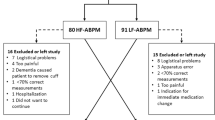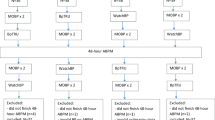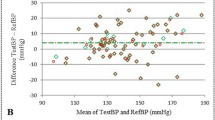Abstract
Orthostatic hypotension (OH) is defined as a drop in systolic blood pressure (SBP) of ≥20 mm Hg and/or a drop in diastolic blood pressure (DBP) of ≥10 mm Hg within 3 min of standing. The international guidelines recommend ideally diagnosing OH with a continuous blood pressure (BP) measurement device, although in daily practice interval BP measurement devices are used more often. We aimed to investigate the difference in observed prevalence of OH between an interval and a continuous BP measurement device. A total of 104 patients with a mean age of 69 years were included. The prevalence of OH was 35.6% (95% CI: 26.4–44.8) with the interval BP measurement and 45.2% (95% CI: 35.6–54.8) with the continuous BP measurement device (P = .121). Lin’s coefficient of concordance ranged from 0.47 to 0.59 for the drop in systolic blood pressure and from 0.33 to 0.42 for the drop in diastolic blood pressure. The positive proportion of agreement in diagnosis of OH between the interval and continuous measure was 59.5% and the negative proportion of agreement was 72.5%. Although the prevalence of OH was not significantly different between the continuous and the interval BP measurement devices using a similar amount of measurement, the concordance between interval and continuous measure is low resulting in low positive and negative proportions of agreement in the diagnosis of OH. We conclude that continuous BP measurement cannot be substituted by an interval BP measurement to diagnose OH.
This is a preview of subscription content, access via your institution
Access options
Subscribe to this journal
Receive 12 digital issues and online access to articles
$119.00 per year
only $9.92 per issue
Buy this article
- Purchase on Springer Link
- Instant access to full article PDF
Prices may be subject to local taxes which are calculated during checkout



Similar content being viewed by others
References
Davis BR, Langford HG, Blaufox MD, Curb JD, Polk BF, Shulman NB. The association of postural changes in systolic blood pressure and mortality in persons with hypertension: the Hypertension Detection and Follow-up Program experience. Circulation. 1987;75:340–6.
Masaki KH, Schatz IJ, Burchfiel CM, Sharp DS, Chiu D, Foley D. et al. Orthostatic hypotension predicts mortality in elderly men: the Honolulu Heart Program. Circulation. 1998;98:2290–5.
Aronow WS, Lee NH, Sales FF, Etienne F. Prevalence of postural hypotension in elderly patients in a long-term health care facility. Am J Cardiol. 1988;62:336
Hartog LC, Cizmar-Sweelssen M, Knipscheer A, Groenier KH, Kleefstra N, Bilo HJ, et al. The association between orthostatic hypotension, falling and successful rehabilitation in a nursing home population. Arch Gerontol Geriatr. 2015;61:190–6.
Ooi WL, Hossain M, Lipsitz LA. The association between orthostatic hypotension and recurrent falls in nursing home residents. Am J Med. 2000;108:106–11.
Poon IO, Braun U. High prevalence of orthostatic hypotension and its correlation with potentially causative medications among elderly veterans. J Clin Pharm Ther. 2005;30:173–8.
The Consensus Committee of the American Autonomic Society and the American Academy of Neurology. Consensus statement on the definition of orthostatic hypotension, pure autonomic failure, and multiple system atrophy.Neurology. 1996;46:1470.
Lahrmann H, Cortelli P, Hilz M, Mathias CJ, Struhal W, Tassinari M. EFNS guidelines on the diagnosis and management of orthostatic hypotension. Eur J Neurol. 2006;13:930–6.
Romero-Ortuno R, Cogan L, Foran T, Kenny RA, Fan CW. Continuous noninvasive orthostatic blood pressure measurements and their relationship with orthostatic intolerance, falls, and frailty in older people. J Am Geriatr Soc. 2011;59:655–65.
Caine SE, Alsop K, Mac Mahon M. Overlooking orthostatic hypotension with routine blood-pressure equipment. Lancet. 1998;352:458
Pasma JH, Bijlsma AY, Klip JM, Stijntjes M, Blauw GJ, Muller M, et al. Blood pressure associates with standing balance in elderly outpatients. PLoS ONE. 2014;9:e106808.
Rogoza AN, Pavlova TS, Sergeeva MV. Validation of A&D UA-767 device for the self-measurement of blood pressure. Blood Press Monit. 2000;5:227–31.
Imholz BP, Settels JJ, van der Meiracker AH, Wesseling KH, Wieling W. Non-invasive continuous finger blood pressure measurement during orthostatic stress compared to intra-arterial pressure. Cardiovasc Res. 1990;24:214–21.
KH W. FinometerTM User’s Guide. 1.10th ed. Hasselt: Pragma ADE; 2002.
Netea RT, Lenders JW, Fau - Smits P, Smits P, Fau - Thien T, Thien T. Influence of body and arm position on blood pressure readings: an overview. J Hypertens. 2003;21:237–41.
de Vet HC, Mokkink LB, Terwee CB, Hoekstra OS, Knol DL. Clinicians are right not to like Cohen’s kappa. BMJ. 2013;346:f2125
Lin LI. A concordance correlation coefficient to evaluate reproducibility. Biometrics. 1989;45:255–68.
Ludbrook J. Linear regression analysis for comparing two measurers or methods of measurement: but which regression? Clin Exp Pharmacol Physiol. 2010;37:692–9.
Bland JM, Altman DG. Statistical methods for assessing agreement between two methods of clinical measurement. Lancet. 1986;1:307–10.
von Elm E, Altman DG, Egger M, Pocock SJ, Gotzsche PC, Vandenbroucke JP. et al. The Strengthening the Reporting of Observational Studies in Epidemiology (STROBE) Statement: guidelines for reporting observational studies. Int J Surg. 2014;12:1495–9.
Alagiakrishnan K, Patel K, Desai RV, Ahmed MB, Fonarow GC, Forman DE, et al. Orthostatic hypotension and incident heart failure in community-dwelling older adults. J Gerontol A Biol Sci Med Sci. 2014;69:223–30.
McJunkin B, Rose B, Amin O, Shah N, Sharma S, Modi S, et al. Detecting initial orthostatic hypotension: a novel approach. J Am Soc Hypertens. 2015;9:365–9.
Ooi WL, Barrett S, Hossain M, Kelley-Gagnon M, Lipsitz LA. Patterns of orthostatic blood pressure change and their clinical correlates in a frail, elderly population. JAMA. 1997;277:1299–304.
O’Connell MD, Savva GM, Fan CW, Kenny RA. Orthostatic hypotension, orthostatic intolerance and frailty: The Irish Longitudinal Study on Aging-TILDA. Arch Gerontol Geriatr. 2015;60:507–13.
Wieling W, Schatz IJ. The consensus statement on the definition of orthostatic hypotension: a revisit after 13 years. J Hypertens. 2009;27:935–8.
Braam EA, Verbakel D, Adiyaman A, Thien T. Orthostatic hypotension: revision of the definition is needed. J Hypertens. 2009;27:2119–20.
Freeman R, Wieling W, Axelrod FB, Benditt DG, Benarroch E, Biaggioni I, et al. Consensus statement on the definition of orthostatic hypotension, neurally mediated syncope and the postural tachycardia syndrome. Clin Auton Res. 2011;21:69–72.
Frith J. Diagnosing orthostatic hypotension: a narrative review of the evidence. Br Med Bull. 2015;115:123–34.
Author information
Authors and Affiliations
Corresponding author
Ethics declarations
Conflict of interest
The authors declare that they have no conflict of interest.
Electronic supplementary material
Rights and permissions
About this article
Cite this article
Breeuwsma, A.C., Hartog, L.C., Kamper, A.M. et al. Diagnosing orthostatic hypotension with continuous and interval blood pressure measurement devices. J Hum Hypertens 32, 831–837 (2018). https://doi.org/10.1038/s41371-018-0091-9
Received:
Revised:
Accepted:
Published:
Issue Date:
DOI: https://doi.org/10.1038/s41371-018-0091-9
This article is cited by
-
Autonomic dysfunction in post-COVID patients with and witfhout neurological symptoms: a prospective multidomain observational study
Journal of Neurology (2022)
-
Orthostatic blood pressure changes and physical, functional and cognitive performance: the MELoR study
Clinical Autonomic Research (2020)



